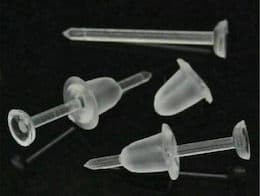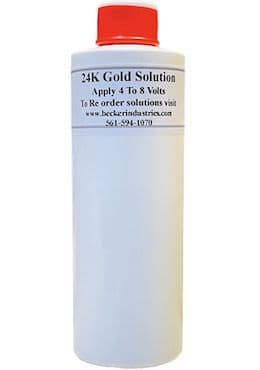
-----
Gold plating on sterling silver, Vermeil
"Vermeil" indicates a type of high quality costume/imitation gold jewelry -- not solid gold, but very high quality. It means the jewelry started by being made of solid sterling silver (which in turn means a least 92.5% pure silver; you can't use some cheaper material and call it vermeil). Then it was gold plated to a thickness of about 2-1/2 µm / 0.0001" (which is about 16X as thick as "TV-quality" gold plated jewelry). In very low-wear situations it can probably last a lifetime.
Q. Hi,
We are currently making 18K gold vermeil plated jewellery, the base metal is 925 Sterling Silver. We are not using nickel because of the allergy/irritation issues. What processes can we put into place to ensure the plating lasts a long time and is durable?
- Kerala, India
May 15, 2024
A. Hi Neelima. A barrier layer of palladium would be ideal. A hard 18K gold plating of Vermeil thickness could last a lifetime in a low wear situation like a broach, and a few years on necklaces and bracelets. Although your mileage may vary, the gold plating is 2-1/2X as thick as micron gold which is considered moderate quality. And the jewelry could be clear coated on top of that.
Luck & Regards,

Ted Mooney, P.E. RET
Striving to live Aloha
finishing.com - Pine Beach, New Jersey
Ted is available for instant help
or longer-term assistance.
Q. Hi,
Can PVD coating be done on 925 silver? Like an 18K gold PVD layer?
Thanks,
- Kerala, India
May 18, 2024
A. Hi again.
Yes, but this question doesn't seem to flow from your previous one, and is abstract, so there is great potential for misunderstanding each other ...
Firstly, although gold can be applied by PVD processes, when people use the phrase "PVD gold" they are usually referring to gold colored titanium nitride coatings, not real gold. These are usually applied on stainless steel or nickel-chrome plating not directly on silver. It seems a little strange to start with real sterling silver jewelry and then put imitation gold on it. It seems more practical to start with stainless steel or nickel-chrome plated brass, and then apply the PVD titanium nitride.
Whether real gold is applied by plating or PVD the same diffusion issues would apply; Real gold PVD is usually for very thin coatings, not for 2-1/2 micron vermeil.
Experts can spot the color difference between real gold and titanium nitride but my eyes aren't good enough. I understand that some premium watches include PVD titanium nitride coatings followed by a thin gold coating to give the correct color.
If you're looking for the cachet of vermeil -- authentic gold on sterling silver -- PVD coatings are not the path forward. But if you are just looking for wear resistance and a general gold color, PVD titanium nitride coatings on nickel-chrome plated brass (or even stainless steel) are probably more practical and cost effective than vermeil. Of course, you need sufficient production volume to support PVD processes.
Luck & Regards,

Ted Mooney, P.E. RET
Striving to live Aloha
finishing.com - Pine Beach, New Jersey
Ted is available for instant help
or longer-term assistance.
⇩ Related postings, oldest first ⇩
Q. I have tried gold plating sterling silver before, and have never had luck. I will clean with a sodium hydroxide formula then I will rinse and try to etch with a sulfuric acid etcher and it immediately get a black coating on it. what should I do to gold plate sterling silver? I use a potassium cyanide gold.
Much Appreciation
Barrett

Barrett Russell
Saskatoon, Saskatchewan, Canada
2000
A. It is not advisable to directly electroplate pure 24 karat gold over sterling silver. A barrier is needed between these two metals. Thin layers of electroplated gold will diffuse slowly into the sterling silver substrate and eventually will develop a dark green to grey color.
Try polishing the silver surface first with a buffing wheel. Clean it in a ultrasonic cleaner or any neutral solution.( Do not use any strong acid or alkaline solution) . Dry it and give a "bright nickel flash" plating first. Bright nickel flash plating solutions may be purchased from any precious metal plating vendors. One such company is Technic of Warwick, Rhode Island. After rinsing and drying, you may now acid gold plate the part successfully on top of the bright nickel surface.
Rapid City, South Dakota, USA
Q. Hi, thank you for this information. Is the nickel coating you recommend here problematic for jewelry wearers who have an allergic reaction to nickel? If so, is there another solution that will create the barrier required for long-lasting 1 micron gold plating on top of sterling silver?
Thanks!
- Gurgaon, Haryana, India
February 14, 2013
A. Hi. Yes, the nickel can be problematic these days, and is probably forbidden in Europe. White bronze plating (an alloy of three metals) is an accepted substitute, but you probably must buy this as a proprietary solution from a plating process supplier as it is very tricky to formulate and operate white bronze plating baths.
Regards,

Ted Mooney, P.E.
Striving to live Aloha
finishing.com - Pine Beach, New Jersey
Ted is available for instant help
or longer-term assistance.
Q. I bought a small DC gold plating kit. I have an old inkwell made of brass that was originally gold plated. I want to replate it, but want a finish that is flat (dull) or satin. I have heard some call it vermeil. I want it to look old, therefore a shiny gold is not desired. Can I control the gold plating by either the gold solution or not highly polish the piece to apply the finish I desire? Any help would be greatly appreciated.
Hollis Hansonhomeowner - Friant, California
2004
A. The finish you want is the finish you should achieve before plating. So if you sand blast your item to give it a satin finish, you will be able to plate and maintain the same finish.
Alan LewisWatch/Clockmaker and Goldsmith - UK
Q. I am going for a white gold look on a ring. Which is a better plating material -- rhodium or vermeil?
Gail Saenzindividual - Clinton TWP, Michigan, U.S.A.
2005
A. Hi Gail,
"White gold" rings are made of white gold (this is an alloy of gold plus whitening agents like nickel or palladium) and they are then rhodium plated for the brightest white color, brilliance and scratch resistance. If you are interested, we wrote an FAQ on "Understanding White Gold & Rhodium Plating" to quickly explain exactly what white gold actually is, and why it is usually rhodium plated today.
Vermeil is not a type of plating; rather it means jewelry that is made of sterling silver which has then been gold plated 2-1/2 microns thick so it looks like solid gold. Read on, and Neil Bell explains that Vermeil is not just a "look" but has a legal meaning you would need to comply with.
Vermeil is probably fine for all kinds of jewelry. But remember: because of where & how they are worn, and that they're often worn every day rather than occasionally -- rings get so much wear that any plating on their surface has a rather limited life.

Ted Mooney, P.E.
Striving to live Aloha
finishing.com - Pine Beach, New Jersey
Ted is available for instant help
or longer-term assistance.
Q. I am not a jeweler but I have a jewelry/metal question. I received some sterling silver earrings as a gift, but I am allergic to them. Is there any way to plate the posts and backs of these earrings in gold so I will be able to wear them? If so, where can I go for this and is it worth it to do so? I like the earrings quite a bit and don't want to have to return the gift.
Christine Guarinonon-jeweler - New Paltz, New York
2005
A. Sure, they can be gold plated. There might be a gold plater near where you live, or you could check with jewelers or better department stores. they sometimes have contacts with plating shops which will do consumer goods.

Jeffrey Holmes, CEF
Spartanburg, South Carolina
A. If you like the look of the sterling silver, but are allergic to the metal the best thing to do is buy the plastic sleeves that fit over the posts and the plastic earring back. a set of six sleeves and backs can be purchased at your local department store (example: Wal-Mart, K-Mart, Target, etc.) for under $5. I have the same problem and they work for me.
Char Roberts- Irvine, California
2005
Is a vermeil plating business a realistic idea?
Q. Hi,
I have recently purchased a small electroplating immersion station with four tanks. My plan is purchase good quality sterling silver jewelry and turn it into high quality vermeil, perhaps also using platinum accents. However, I've heard that vermeil jewelry will tarnish very quickly. Is this true, and if so, can anything be done to avoid the tarnishing?
Also with China and India able to produce jewelry very cheaply, is it realistic that I could enter the market from a domestic house using a small unit? I think that it would be impossible to compete on price, so I would have to rely on the quality of the jewelry as my selling point.
Any comments would be welcome.
Best wishes,
hobbyist - Manchester, UK
July 4, 2009
by Reid & Goldie
-- hard to find & expensive; if you see a copy cheap, act fast!
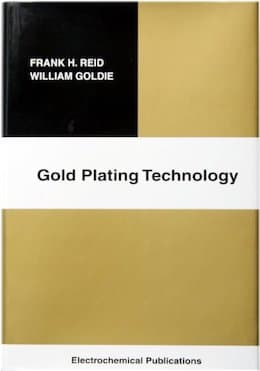
on eBay or Amazon
or AbeBooks
(affil link)
A. Hi, Stephen.
One thing in your favor is that the average purchaser is not doing careful cost comparisons; rather, they want to spend $xxx on a present for their wife and get something pretty. Another thing in your favor is that precious and semi-precious metals are expensive, so the cost of labor is proportionally not as important in jewelry as in commodity items.
Yes, gold plating on silver will diffuse into it (mix with it) leading to tarnish, and the work-around can be an initial plated layer of something like nickel plating or white bronze that does not diffuse with silver or gold. But if the plating really is 100 µin. thick, it can take a good while for that diffusion.
As for business success, if you bring something to the table -- be it outstanding salesmanship, an irrepressible enthusiasm, or a real flair for jewelry design -- success is certainly possible. But we encounter similar questions on other topics like bronzing of shoes, and we tell people that being able to sell the product is the most important part! If you can't sell the shoes, there's no sense making them; and if you can sell them, there's no need to actually make them, you can just re-sell them and let somebody else do the grunt work :-)
Please focus on how you can market your product, how you will find distributors or jewelers, how you will get people enthusiastic about what you have to offer. If, after you do that, you decide that doing the plating in a domestic house would be a useful part of the plan, then you can investigate the potential downsides of that idea. I would hope that your plan can work with the electroplating being done in an industrial rather than domestic setting because it does involve the use of dangerous chemicals. Good luck.
Regards,

Ted Mooney, P.E.
Striving to live Aloha
finishing.com - Pine Beach, New Jersey
Ted is available for instant help
or longer-term assistance.
Durability of Vermeil Beads on Bracelets
Q. I am purchasing a Pandora bracelet. I am looking at many different types of beads and safety chains, many of which are "vermeil" plated. Is vermeil plating durable enough to withstand the wear and tear of being next to other beads on a bracelet? Is this a viable option to solid gold?
Amanda Kochbuyer - Hoagland, Indiana, USA
July 23, 2009
1 µ (micron or micrometer) equals 39.37 µin. (microinches or millionths of an inch), so 2-1/2 microns is 98.4 µin. (approx. 100)
A. Vermeil is 2.5 microns of gold over sterling silver and will last longer than an item plated with only a few millionths of an inch of gold but it is not solid gold. If you want the performance of solid gold then that's what you should purchase.
Neil BellAlbuquerque, New Mexico
Q. I am trying to gold plate a sterling silver round dome plate 136.0 mm in diameter by 0.5 mm in thickness. It covers a gold plated chalice. Should it be nickel plated before the gold plating? The solution I plan to use is Clean Earth 24kt. No. 45.216. Our Plating unit is a Riogrande Midas 335.048 up to 6.0 Volts. Any suggestions?
Charles Smith- Charlotte, North Carolina
August 12, 2009
A. Hi, Charles. The gold and silver will tend to diffuse together, so it is best to have a layer of nickel plating between them (or white bronze if this is going to Europe). Please see thread 52625 for more info on the diffusion issue. Good luck.
Regards,

Ted Mooney, P.E.
Striving to live Aloha
finishing.com - Pine Beach, New Jersey
Ted is available for instant help
or longer-term assistance.
How does 950 silver jewelry need to be marked per jewelry standards regulations?
Q. Hi, my name is Eli I am a jewelry designers that started producing the pieces in our in-house workshop. We are currently using 950 silver. We want to comply with jewelry standard regulations on how we need to mark our jewelry pieces? For 950 silver? we are also plating 950 silver pieces with 14k gold, some with more microns than other.
We are also interested in exporting our pieces to US and latin america we would like also the requirements in marking the pieces...is there any specific ISO?
All advice will be greatly appreciated.
Thanks.
manufacturer - San Juan, Puerto Rico
November 4, 2009
A. Are you sure that the silver purity is .950?
Sterling silver is .925 silver and can be marked sterling or .925 along with your trademark.
You will need to gold plate your sterling jewelry at least 2.5 microns thickness to label it Vermeil.
Albuquerque, New Mexico
Possible Purple of Cassius on Gold Vermeil
Q. Hi folks...
My name is Marc Robinson from California and am writing this to you all from Qingdao, China. I have been in jewelry production manufacturing for 35 years and for the last 5 years, have been in the Far East consulting for factories from China to Thailand to India and also in Bali, Indonesia.
I have come across a factory here in China that does 14K gold vermeil plating on sterling silver. (For the US market) I have samples in front of me that have a severe discoloration in very deep hues of purple and deep blue. It is sporadic across the jewelry pieces but is very vibrant in color and depth of discolor. Could this be Purple of Cassius condition that I have read about in the past? If I recall, a possible cause is tin chloride that has contaminated the gold bath...possibly coming from nefariously bad Chinese solder found on some items that are plated. Another cause that I read is stannic acid. Can anyone tell me if this is possibly P of C...or any other diagnosis you would care to offer? Where do I look for possible contamination? Any ideas to a solution?
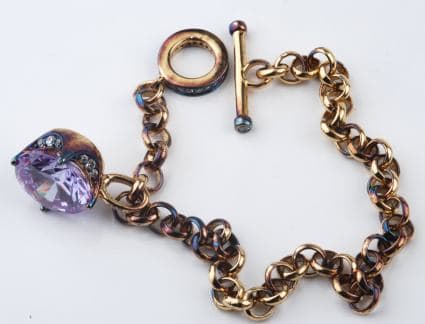
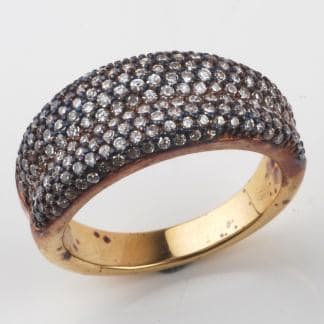
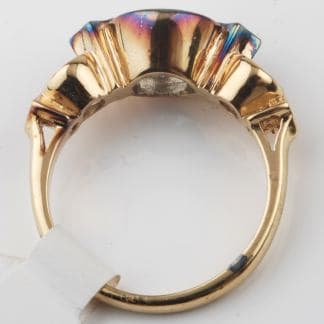
Thanks much ahead of time....
- Qingdao, China
September 1, 2010
A. Marc. I think you are seeing silver migration through the gold plating. That would imply that the gold is very thin, less than one micron.
First off, you should have a reputable lab measure the gold thickness, then either increase gold thickness to 2 or 3 microns, or plate a nickel barrier between the silver and gold.

Jeffrey Holmes, CEF
Spartanburg, South Carolina
Q. Hi,
I want to gold plate silver jewelry. I am looking for solution to gold plate silver jewelry.
After lots of research on internet I found that there should be barrier between silver and plated gold else plated gold fade away in few months. Even if we do very thick gold plating on silver then also it will fade away eventually.
To avoid this we may need to plate silver first with Copper or nickel or white bronze etc. White bronze is advisable compared to others I think.
I am looking for complete solution/kit to gold plate silver jewelry which also take care of barrier coating of white bronze (or any which is not allergic) on silver before gold plating. Could you please provide details on the solution which I am looking for or details of any other related product which can do similar task.
I want to gold plate silver jewelry with professional finish and should last for at least 3 years.
Thanks
- India
July 24, 2013
by Reid & Goldie
-- hard to find & expensive; if you see a copy cheap, act fast!

on eBay or Amazon
or AbeBooks
(affil link)
A. Hello Himanshu. If you have the patience for a careful search, the topic of durable yet affordable gold plating has been covered in detail many times on these pages. But it is difficult to get a consensus for many reasons, including: some people are satisfied with a gold "look", while others demand real gold; PVD coatings are very economical in high volume but prohibitive in low volume; electrocoating is economical in medium volume but not practical for custom onesy-twosies.
Still, to summarize in a single paragraph: thick gold plating would easily do it -- gold plated pocket watches have lasted a century -- but it is considered far too expensive today. So if you do not want to put on enough gold to last three years, you must either replace some or all of the gold with a titanium nitride or similar PVD coating (which will only be practical at high volume), or you must clear coat it.
I suspect from my reading here, but do not know from personal experience, that white bronze plating, followed by "micron gold" (gold plating of thickness 1 µ / 40 microinch), followed by a good clearcoat (preferably e-coating, but UV hardened coating if volume is too low) would be considered good quality for costume (imitation) jewelry. My guess is it might last 3 years of rather occasional (not every day) use. Good luck.

Ted Mooney, P.E.
Striving to live Aloha
finishing.com - Pine Beach, New Jersey
Ted is available for instant help
or longer-term assistance.
Q. My engagement ring was a silver color, but we wanted gold. So the jeweler did some kind of plating/finish on it. It has only been 6 months and its changing back to its original silver color. What is the solution.
MICHELE QUAST- st thomas virgin islands
June 11, 2014
A. Hi Michele. Engagement rings are worn every day as well as being very high wear items. The bad news is that no practical amount of gold plating will last through your marriage. If you go to a specialty jewelry plating shop, and they apply a lot of gold, and then apply a top quality clear coat, it might, maybe, last a couple of years.
If the ring was a family heirloom, get used to the silvery color; it's the best answer. If the jeweler sold you a new engagement ring and then plated it a different color, he really should have known better; there was no chance of long term success. If you and your fiancee can accept the change to such an emotionally charged item, get a yellow gold setting.
P.S.: I vacationed on your beautiful island last year; Secret Harbor is the nicest beach I've ever seen -- so where can you travel to for your honeymoon that could be better? :-)
Regards,

Ted Mooney, P.E.
Striving to live Aloha
finishing.com - Pine Beach, New Jersey
Ted is available for instant help
or longer-term assistance.
![]() Hello,
Hello,
If the marriage will last longer than the gold plating consider it a blessing!!
Process Engineer - Malone, NY USA
Q. Living in Miami, our silver candlesticks, flatware and other items tarnish terribly. I would like to have them gold plated with White gold to keep the look. The candlesticks are ornate and have significant detail work.
Does white gold plating exist?
Does it work with ornate candlesticks?
Do I need a nickel or other middle layer?
How thick should it be? candlesticks? flatware? (used once to twice a week)
Does anyone have a recommendation of a professional in the Miami area with experience?
Does the silver need to be professional polished first?
What is a ballpark figure for what it should cost?
Any other thoughts or recommendations welcome.
Thank you
Elly
- miami Florida usa
December 21, 2014
A. Hi Elly. As you may know, there is no isotope of gold that is white -- white gold is an alloy of yellow gold with palladium and/or nickel. I'm not personally aware of white gold plating being available; it's not easy to get different metals to electroplate in the right proportions to form the desired alloy and correct color, and it's possible that it hasn't been achieved. Platinum or rhodium plating are possibilities.
This plating can be very thin, and will not at all interfere with ornate patterns. I think your best bet for the candlesticks would be a thin layer of rhodium plating. Silver items often receive a thin plating of rhodium to deter tarnish that doesn't completely detract from the look of silver. I don't think I would rhodium plate flatware though because I've never heard of it; and although I wouldn't anticipate any safety issue, I wouldn't want to be the only family in the world trying a health experiment; plus it's too thin to work for long. If you learn of the availability of rhodium plated flatware, that would change things.
Sorry, we can't suggest vendors (why?).
Regards,

Ted Mooney, P.E. RET
Striving to live Aloha
finishing.com - Pine Beach, New Jersey
Ted is available for instant help
or longer-term assistance.
Q. I have a 925 sterling silver band size 12, 15mm wide band -- a double small chain link top and bottom with elephants walking all around it. Just giving you this info in case it matters which it probably does not.
I can polish it on my loose muslin wheel with white rouge ⇦ on eBay or Amazon [affil link] and it comes out great, but dulls in about 2 weeks. Where can I send it to have it plated in 14 or 18 Karat gold so it will last for years? Can they plate it 2 or 3 times so its thickness will stand up and I can buff it every so often so it looks great? Thank you for your time!
richard roterud- Mesa Arizona
February 25, 2015
A. Hi Richard. Yes, your band can be plated either with rhodium to retain the silver look or with gold. The gold plating could be very heavy if you're willing to pay for it. If a local jeweler can't do it, plating shops specializing in jewelry probably can. Still a ring worn everyday endures extreme wear; you've probably seen rings worn all the way through, let alone through the thousand times thinner plating.
You may or may not like the look, but it might also be possible to clearcoat it yourself with automotive clearcoat or UV-curing lacquer. Good luck.
Regards,

Ted Mooney, P.E. RET
Striving to live Aloha
finishing.com - Pine Beach, New Jersey
Ted is available for instant help
or longer-term assistance.
Plating with color formation which looks like natural flow
Q. Dear sir,
Recently I came across a newly patented process, viz.,
1. precision casting of precious metal jewelry using natural materials.
2. pipe type fine metal thread manufacturing method & the fine metal threads using porous metals
3. methods to apply gradation to ornaments and the ornaments that are formed with gradation.
These processes are used to exactly replicate the color formation in a flow or any other object found naturally in nature by plating process.
What exactly are these processes and how are these done? Can someone please shed light on these subjects?
I am very much interested in knowing more on these subjects as I want to apply these procedures in production of jewelry.
Can anybody help?
I would be grateful if anybody can shed light on these subjects.
Awaiting for your reply,
Best regards,
- Mumbai, Maharashtra, India
September 25, 2015
A. Hi Prakash. Patents are on the internet in our modern world; do the search. Naturally, unless you only want to do one for yourself and try to fly below the radar, you can't do them yourself without licensing the process from the patent holder anyway.
Regards,

Ted Mooney, P.E. RET
Striving to live Aloha
finishing.com - Pine Beach, New Jersey
Ted is available for instant help
or longer-term assistance.
Q. I am producing sterling silver jewellery and using gold plating technique. But the gold thickness is not much so it lasts only 1 month or 2. Now, I want to do vermeil for my sterling silver which increase the thickness to 2-1/2 Micron but I don't know any company providing these techniques and liquids. Please help me! Thanks.
Tam Thanhproducer - HCM, Vietnam
January 22, 2016
A. Good day Tam.
Try the company TECHNIC, they are a supplier of gold plating solutions.
Best of luck. Regards,
Aerotek Mfg. Ltd. - Whitby, Ontario, Canada
A. Hi,
I have owned a pair of Vermeil Earrings for 31 years now. I did find that they tarnish, but I found a way to bring them back to brand new condition. I have a liquid Silver dipping cleaner that I use on them and they are as beautiful as the day I purchased them. So, easy to say that Vermeil is my preference for long wearing Jewelry, but hard to find these days.
Suse
- Las Vegas, Nevada USA
July 25, 2016
Readers are welcome to browse this site anonymously!
-- but its main purpose is worldwide camaraderie through sharing,
so readers wanting that might not engage with anonymous posters.
Q. I am trying to figure out how thick (in mm) the surface will be if we electroform at 0.1 amps per square inch for 1 hour. The metal we would be electroforming onto would be silver, What is the accepted thickness for gold electroforming on jewelry. This would be done with a pulse plating supply.
vic masciarelli- Northborough, Massachusetts
May 29, 2016
A. Hi Vic.
(affil links)

free pdf is currently available from academia.edu
Let me quibble over a possible semantics issue first :-)
Unless I am misunderstanding what you are doing, most of us might call it electroplating rather than electroforming. The difference being that we call it electroforming only if the plating layer itself becomes structural, for instance if you were plating gold onto wax and then melting the wax away to create hollow gold earrings, with the gold plating becoming the object. Microwave guides, record stampers, and flexible bellows are some other typical electroforms. But I am not sure that I understand after all :-)
Faraday's Law will tell you the thickness of gold plating you would get if your process operated at 100% efficiency (with none of the electricity going to the liberation of hydrogen instead of deposition of gold). The Metal Finishing Guidebook ⇨
has a handy chart on page 812 which integrates the various conversion factors involved in Faraday's Law calculations and ends up giving you the number of Ampere-Hours per square foot required to deposit 0.001" thickness of plating. For aurous solutions it is 6.2, and for auric solutions it is 18.6. From this 3:1 variation you can see that you need to tell us what kind of gold plating solution you are using before we can get too far; it's probably aurous, but your vendor can certainly tell you. Efficiency can also vary widely: it's usually 90-100% for cyanide golds but can be somewhat lower for neutral golds, and significantly lower for non-cyanide or bright acid gold baths.
So, as you can see, it isn't possible to estimate the thickness you are depositing from the time and current without some input regarding the gold plating solution being used.
There is no "accepted thickness". We have dozens of threads here discussing the topic of gold plating thickness, and it ranges from zero (tinted electrophoretic lacquers or PVD hard coatings in lieu of gold), through a few tenths of a micron for very cheap costume jewelry, on to about 1 micron for moderate quality costume jewelry, then onto 2-1/2 micron gold plating over silver (Vermeil) for high quality, all the way to 7 microns and even more for super-premium watches.
Get back to us with more info and the readers can probably offer additional responses. Good luck.
Regards,

Ted Mooney, P.E. RET
Striving to live Aloha
finishing.com - Pine Beach, New Jersey
Ted is available for instant help
or longer-term assistance.
Q. Hi Guys,
My Gold plating Supplier is seeing some issues when gold plating a thick layer (3 Microns or more) on our sterling silver jewellery.
We see this issue mostly on highly polished/mirror polished pieces. It shows as stains or a patchy / Flamelike finish:
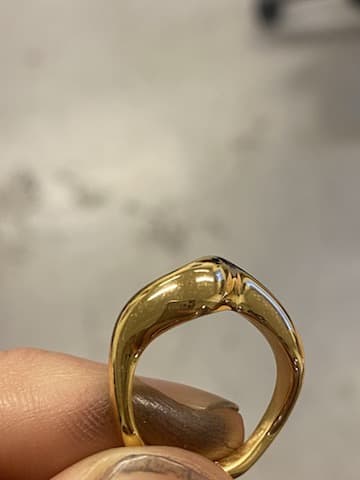
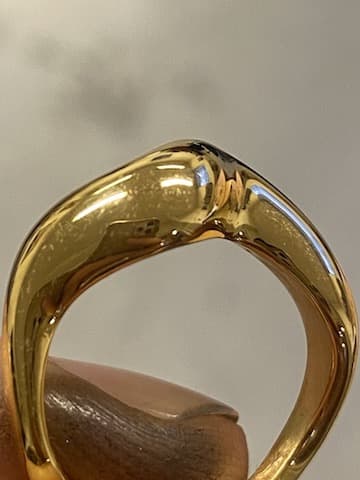
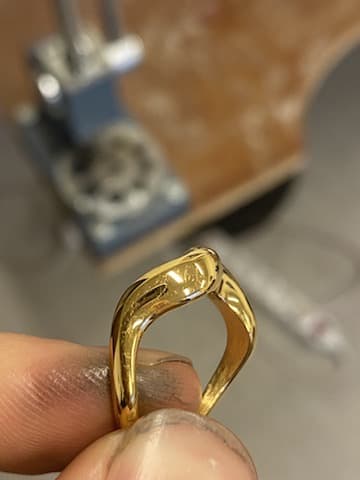
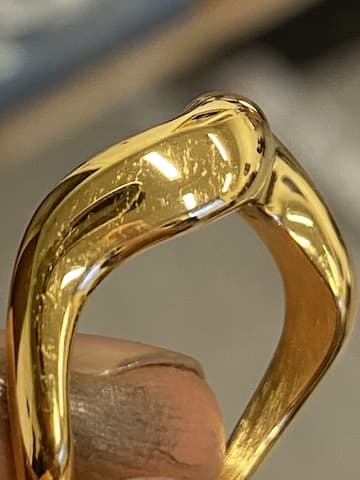
If we go over the jewellery quickly on our buffing wheel afterwards, the stains get removed, and we still have most of our gold layer intact. So this means that the stains are shallow and probably just on the outer layer of the plating.
Of course this is a lot of extra work and money to need to buff the pieces after plating, so this is not a good solution.
If you look at attached images, does anybody know what the reason could be? And how we could avoid this issue?
Super Grateful for any tips or thoughts that I can forward to our gold plating supplier.
Kindest regards
Jimmy
- BORAS VASTRA GOTALAND, Sweden
December 17, 2020
A. Silver will migrate thru 3 microns (0,0001 inch) of gold in a very short time. Insert a layer of palladium for a diffusion barrier.

Robert H Probert
Robert H Probert Technical Services
Garner, North Carolina

A. Hi Jimmy. Our colleague Robert is almost alway right, and he may be right that a diffusion barrier is worthwhile ... but I personally don't believe it's the cause of your posted problem.
Luck & Regards,

Ted Mooney, P.E. RET
Striving to live Aloha
finishing.com - Pine Beach, New Jersey
Ted is available for instant help
or longer-term assistance.
Q. Hi guys,
Thanks for your answers, we actually already have a barrier plating of Palladium on all our pieces, so this is not the issue.
Thanks anyway and If anyone else have seen something similar before or have an Idea What the Cause could be I would be very grateful.
Kind regards
Jimmy
- BORAS VASTRA GOTALAND, Sweden
December 19, 2020
A. Hi again. Are you sure you are doing thorough DI rinsing? If you have a vapor degreaser in your facility you could try using it immediately after plating (parts still wet) as a "vapor dryer" and tell us if it changes anything.
Luck & Regards,

Ted Mooney, P.E. RET
Striving to live Aloha
finishing.com - Pine Beach, New Jersey
Ted is available for instant help
or longer-term assistance.
(You're on the 1st page of this topic) Next page >
Q, A, or Comment on THIS thread -or- Start a NEW Thread
